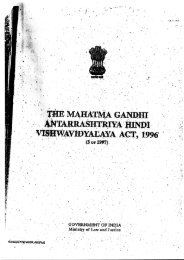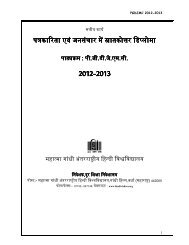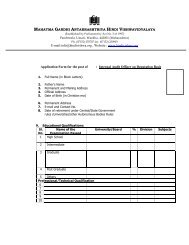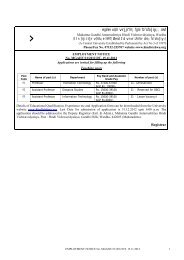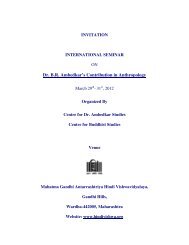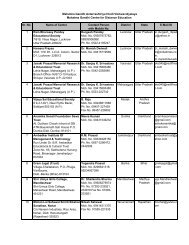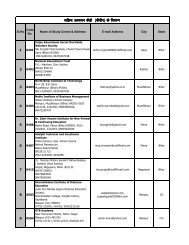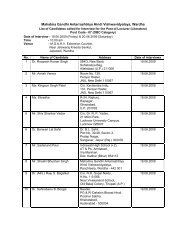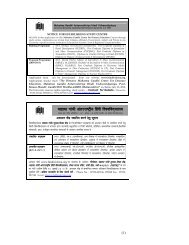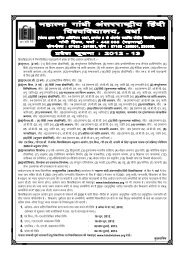others style. It is C. Satyananda whorevealed that the language innovations inArundhati Roy's work were done fifty yearsago by Enid Blyton and The God of SmallThings was no better than an imitationof Toni Morrison's Beloved.In discourse analysis, let us go backto the same passage referred to by RajiNarasimhan : "He didn't know that insome places... Worse things kepthappening." She did deconstruct thisparagraph into three sections and came toa conclusion that it left behind a semanticsfor the natural poetry of free expression.Whether we get the beauteous constructof semantics and poetic fervour from <strong>Hindi</strong>translation? (Raji Narasimhan, 2013, 139)The paragraph is full of finite noun clausesintroduced by the subordinator that followthe main clause verb. They function assubjects, direct objects, or compliments ofthe main predicate. The <strong>Hindi</strong> syntaxhaving complex structure began with 'Usepata nahin tha ...', and the rest of thesyntactical arrangement is in support ofthe same main clause subordinating withthe word ki. viz. 'Ki jab niji uthal-puthalek raashtra ki vishaal, prachand, chakkarkhati,eid lagaati, haasyaspad, unmath,asangat, saarvajanik uthal-puthal ki, sadakkinaarebani, samaadhi par pahunchti tokuch ghatit hotaa. Ki vah badaa devta garmhava ki taraf chikhta aur sijade men sirjhukane ki maang karta.' (Neelabh, 2008,32). The deviation that can be mentionedhere is in the tense of the verb, in thosesubordinate clauses, which distanced thewhole sense of the TL. Main verb is putin simple past as that of the original, butthen Neelabh changed the latter phrasesin conditional past, that deviated the senseof TL text. But it is made clear with thebeginning of each adjectival phrase withthe conjunction ki. Raji also made it clearthat 'scrambling up the language is aprominent feature of Roy's prose style andform. But the scramble you come up with,alas, is devoid of the method gone intoRoy's creative scramble.' (ibid, 140). Thereaders in <strong>Hindi</strong> can also reach the sameconclusion. Three sub-clauses are there inthe original paragraph, without muchsemantic variations — 'that somethinghappened' / 'worse things had happened' /'things kept happening.' So beginning withthe past and continuing with the perfectand going to the eternal present the wholesequence of narration is taking the readerto strengthen the character of Larry, thehusband of Rahel to look into the thirdworld citizen in tears always, and thatbecomes the predicted ending of therelation between that couple. Towards theend of the paragraph, the novelist madeit literal : 'In the country that she (Rahel)came from, poised forever between theterror of war and horror of peace, worsethings kept happening.' (Arundhati, 2002,19)It is Arundhati the novelist who utteredthat 'I don't see a great difference betweenThe God of Small Things and my nonfiction.In fact, I keep saying, fiction isthe truest thing there ever was... The Godof Small Things is a book which connectsthe very smallest things to the very biggest.'fgndi •April-June 2013 :: 137
The novelist was translating her own lifeinto this fiction. The experiences at thevillage Aymanan in the district of Kottayamin Kerala seem to have left a lastingimpression on Arundhati. Novel completedon April 6, 1996, with four years' time.She told Vir Sangvi, the editor of Sunday :'I just started putting down what was goingon in my head... It was all just comingout of me, like smoke I suppose, and Ikept putting it down.' As observed byArundhati's critic that her novel is not animitation of some western model, but hasbehind her a long and rich tradition ofsocially committed writing in Indo-Angliannovels. It is relevant here, therefore to havea look at this tradition and discover herroots.On translating some of the folk versesand lyrics in the original, Priya could easilyomit the English version, where sometimesthe author had given simultaneousMalayalam and its translation in English.Like the one Kuttappen's appeal to an overripeguava (Arundhati, 207). For thetranslator in Malayalam, Priya could chooseonly those lines as in original Malayalamwithout caring for the re-renderings ofArundhati. Will it be more liberty on theauthor to surpass her? <strong>Hindi</strong> translator hadto transform both languages into target —'Paa pera-pera-perakka (Mr. gugga-gug-gugguava)Ends parambil thooralley (Don't shitherein my compound); correspondingly —Paa pera-pera-perakka (Shri am-am-amamruda)Ende parambil thooralley (yahanmere hate men mat hag dena) (Neelabh,225). Here the translator had takenphonetic adaptation to utter the <strong>Hindi</strong>world for gua — amrud. He did it witha vowel ending — amruda, in the first line,but the same is not opted for the cominglines, that which are of different endingsin original. Again the adaptations for someaspirated consonants in <strong>Hindi</strong> are notscientific as those used in Malayalam script.Arundhati herself scribed those tabus —thoorikko/thooralle with the beginningdental consonant as aspirated, but in realpronunciation of that is non-aspirated.Transliteration of that into <strong>Hindi</strong> did thesame adaptation of making that intoaspirated dental consonant. Similar problemlies in pronouncing the word gua = perakkaand compound = parambu. The allophonesra and ra (as in Raphel) in <strong>Hindi</strong>intonations are not specified. But inMalayalam those two are distinct. Priyacould differentiate them in her TL, butNeelabh was helpless (as Arundhati toowas). Arundhati did this with some of theproper nouns also like the names ofEsthappen, Kuttappen, or compound propername coined like Esthapappychachen,Veluthapappychachen etc. Here again thetranslator went in tune with the novelist,but quite aware of the demarcation betweenthose phonetic adaptations in MalayalamSmt. Priya did coin the exact word. Takingfor granted the ending three consonantsas that of the original, in their translationsNeelabh opted the same phoneme e(spelled as in air). Hence, those words rerenderedin <strong>Hindi</strong> as Kuttappen, Esthappen,Veluthapappychachen etc. School rhymes arealso finding its place in Arundhati's138 :: April-June 2013fgndi •
- Page 1 and 2:
A Journal ofMahatma GandhiAntarrash
- Page 3 and 4:
LANGUAGEArundhati Roy in Indian Lan
- Page 5 and 6:
all is not well with the world. Ult
- Page 7 and 8:
After tallying the anubhavas mentio
- Page 9 and 10:
sustenance. If it fights shy of phi
- Page 11 and 12:
progression from Shringararasabhasa
- Page 13 and 14:
glamour and fame, I always looked a
- Page 15 and 16:
grandmother. Scolded for stealing t
- Page 17 and 18:
of his episodes and characters from
- Page 19 and 20:
The short story Najum (astrology) b
- Page 21 and 22:
India, Indianness and BuddhaDev Bos
- Page 23 and 24:
Buddha Dev Bose's writings on Tagor
- Page 25 and 26:
development of the idea of a worldl
- Page 27 and 28:
defies the set patterns of known li
- Page 29 and 30:
The Concerns of CriticismShambhunat
- Page 31 and 32:
On the basis of feudal thinking the
- Page 33 and 34:
etween the interests of different s
- Page 35 and 36:
silent about Hazari Prasad Diwedi.
- Page 37 and 38:
Imperialism. The imperialists had c
- Page 39 and 40:
conventional reformers to evaluatet
- Page 41 and 42:
expansion of knowledge emotions are
- Page 43 and 44:
unprincipled propaganda takes place
- Page 45 and 46:
drowning with shame or pride in it.
- Page 47 and 48:
made criticism a pure literary subj
- Page 49 and 50:
It is a great paradox that in an ag
- Page 51 and 52:
how much they are mixing with it. M
- Page 53 and 54:
peculiar way of protest against not
- Page 55 and 56:
Radha Worship in Hindi LiteratureL.
- Page 57 and 58:
valuable ornaments and clothes. His
- Page 59 and 60:
literature in general and Hindi lit
- Page 61 and 62:
Not only this the hunger which I go
- Page 63 and 64:
3. We the Janvadi PoetsWe are write
- Page 65 and 66:
5. A FarmerThis time paddy crophas
- Page 67 and 68:
isolated, lonely and stained with p
- Page 69 and 70:
3. A COFFIN AND A BOTTLEIn this roo
- Page 71 and 72:
The omnipresence of your super imag
- Page 73 and 74:
As I look at the black and white pr
- Page 75 and 76:
But when I touched the door of the
- Page 77 and 78:
7. LIFEThat day when I entereda mag
- Page 79 and 80:
2. TEA WITH DONNEGood Morning, dear
- Page 81 and 82:
4. HI, KRISHNA!Hi, Krishna!What’r
- Page 83 and 84:
Malbe Ka MalikMohan RakeshJai Ratan
- Page 85 and 86: 'Everything else has changed but no
- Page 87 and 88: feet, on a brick path near the open
- Page 89 and 90: ightened up on seeing Rakkha Pahalw
- Page 91 and 92: 'So what happened?''Nothing happene
- Page 93 and 94: Mad DelightMohan Rakesh was as much
- Page 95 and 96: In continuous rhythmic movements, h
- Page 97 and 98: is the silence within . . . silence
- Page 99 and 100: ehind. The man remains alone once a
- Page 101 and 102: stretching road ahead."And how much
- Page 103 and 104: the car."Tell me what do you want?"
- Page 105 and 106: "Was it necessary today itself ?" f
- Page 107 and 108: laughed father “not a morsel to e
- Page 109 and 110: Rites for The DepartedChandrakantaR
- Page 111 and 112: gazing at the swiveling waves of th
- Page 113 and 114: salutations to the Ganga : 'These p
- Page 115 and 116: He won his mukti in that instant of
- Page 117 and 118: a rush for a plank she suddenly see
- Page 119 and 120: The Voice Which was Progeny...Tarun
- Page 121 and 122: growl, blare and shouts had compell
- Page 123 and 124: Broken bamboos and thatches strewed
- Page 125 and 126: forest and open land. The man and w
- Page 127 and 128: "But I have already taken the money
- Page 129 and 130: Ramrath and Bhagirathi's fate gave
- Page 131 and 132: than their son.That boy knew this m
- Page 133 and 134: of power of the original to be tran
- Page 135: the time. "That raises a question i
- Page 139 and 140: 13th paragraph, Arundhati used the
- Page 141 and 142: Referencesi. 'Arundhati Roy, transl
- Page 143 and 144: translation of literature in Englis
- Page 145 and 146: Sons published it under its Traditi
- Page 147 and 148: here that he forgot to smile.'"Afte
- Page 149 and 150: are the opulence of royalty, strugg
- Page 151 and 152: wide web (www) which has created ap
- Page 153 and 154: in it move beyond Cultural Studies
- Page 155 and 156: Prize. Wasn't it in the early years
- Page 157 and 158: deep insight into the life and work
- Page 159: 25. Ms. Kanan Jhingan, 48, Swastik



